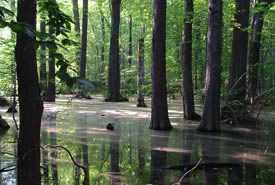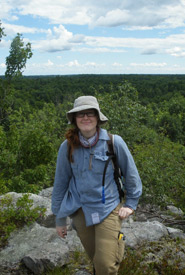Wading through the wonders of wetlands

Forested wetlands in summer (Photo by Mary Gartshore)
Wetlands are dynamic places, where the land is, quite literally, wet. From day-to-day fluctuations, to seasonal changes, the amount of water in a wetland can change over time. As water levels shift, you might not know exactly what to expect when heading out for a stroll through the swamp. So it can be tricky to plan for boots, or waders, or maybe even a canoe. By absorbing all this water, wetlands help to buffer surrounding areas from flooding while releasing it slowly during times of drought. They also act as natural filters to clean water and provide habitat for a large number of species, including many species at risk that depend on these conditions.

Comic by Liv Monck-Whipp/Tails from the field
Over the past hundred years, over 65 per cent of wetlands in Canada have disappeared. Within Ontario, the Nature Conservancy of Canada (NCC) has conserved approximately 18,780 acres (7,600 hectares) of wetlands. This includes many provincially significant wetlands.
In the Southern Norfolk Sand Plain Natural Area, NCC has also created approximately 44 acres (18 hectares) of wetland habitat. Many more wetland creation projects are planned for this natural area. These created wetlands help to restore former agricultural fields into areas where water can settle. As a result, they reduce flooding, improve water quality and support viable, productive ecosystems. These areas begin to flourish almost immediately. Waterfowl and shorebirds arrive here soon after, and toads and turtles breed here within a year or two!


